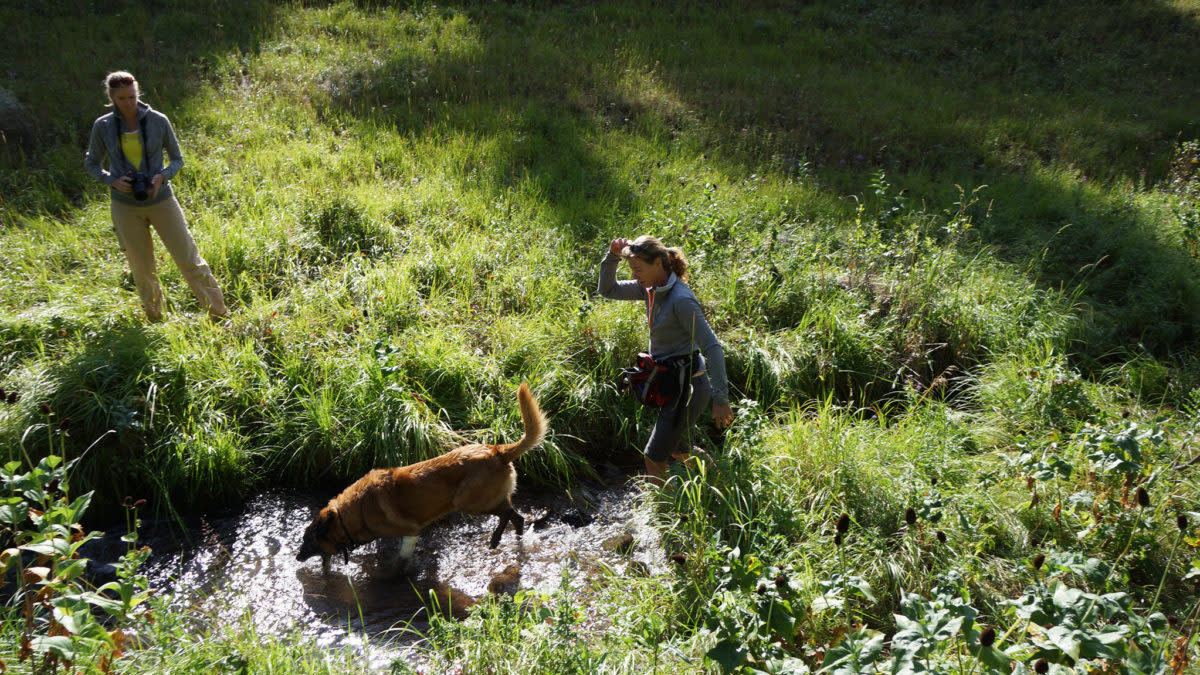
If you’re like me, you’ve been awed time and again by the nose of a good dog. Flushing pheasants out of cattails. Trailing lions in the snow. And now, identifying the species of fish in a trout stream.
That last one is science, not science fiction.
To help conserve native trout, the scientists at Working Dogs for Conservation have proven that dogs can differentiate species of fish, by scent, while the fish are swimming in their habitat.
Executive Director Pete Coppolillo (who is a PhD ecologist and avid bird hunter) explained.
Anglers and fisheries biologists are concerned about native trout such as westslope cutthroat and bull trout. In the West, the introduction of Eastern brook trout has created problems for natives, as brookies can hybridize with bulls, spread disease to and out-compete the cutties.
A big question is, which streams have natives and which have invasive species? It’s a difficult and expensive question to answer. Biologists must generally electro-fish water-by-water to find the facts.
Coppolillo and his colleagues had an idea: Could dogs be trained to smell fish in rivers, like the dogs are trained to smell explosives or narcotics in bags at the airport?
It may seem crazy, but the answer appears to be “yes.”
The dogs were Pepin, a male Belgian Malinois, and two German shepherds, Tia and Rue, trained and handled by Megan Parker and Alice Whitelaw.
First, the trainers wiped slime off two different kinds of wild-caught trout—rainbow and brook trout. In blind experiments, their dogs could accurately distinguish between cloths that wiped slime off rainbow trout, compared to those that wiped slime off a brookie.
Next, they tested the dogs’ abilities in the flowing runways in a fish hatchery. The dogs smelled the water in the runways, and could tell which parts of the runway contained brook trout.
Then they upped the game in a real trout stream in Montana. They put brook trout in underwater cages and tucked them under a bank of a stream that they knew had no wild brookies swimming. They walked the dogs along shore with the wind in their noses. Once again, the dogs nailed it.
The dogs could even identify which fish lived in streams when all they had to smell were buckets of water taken from fish-holding and fish-less creeks.
Coppolillo believes the dogs’ noses pick up molecules that the fish shed, which percolate through the water and then evaporate into the air.
The team at Working Dogs for Conservation is still working out the applications for this discovery in real-world conservation. Trained detection dogs are already being used to identify the microscopic larvae of invasive mussels on boats and the presence of certain whales in salt water. But Coppolillo imagines that dogs could soon help biologists identify which kinds of fish swim in which waters, conserving both native fish and the habitats in which they reside.
Working Dogs for Conservation have trained dogs to detect ivory, bush meat and ammunition to help stop smugglers and poachers in Africa. In North America, their dogs have learned to detect the presence of a disease called brucellosis in elk dung, a concern where elk and cattle share pastures.
As amazing the sense of smell is with dogs, Coppolillo suspects prey animals, like elk and deer, may have even more sensitive noses. Evolution has sharpened the senses of both, but perhaps not equally.
“When a predator’s nose fails it, it goes hungry for a while. But when a prey animal’s nose fails it, it dies.”
Dogs are eager to share what they know with their people—so they easily can be trained to signal to or “alert” their handlers. Wild prey animals, on the other hand, have every reason to keep their perceptions secret.
Feature image via Working Dogs for Conservation.






